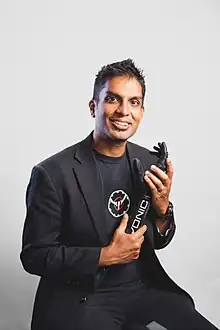Aadeel Akhtar
Aadeel Akhtar is a neuroscientist and electrical engineer. He is CEO and founder of the bionics company PSYONIC. In 2021, he was named one of MIT Technology Review’s 35 Innovators Under 35[1] and was featured in Newsweek’s “America's 50 Greatest Disruptors: Visionaries Who Are Changing the World.”[2]
Aadeel Akhtar | |
|---|---|
 Aadeel Akhtar (2022) | |
| Born | January 15, 1987 Streamwood, Illinois, USA |
| Alma mater | Loyola University Chicago University of Illinois Urbana-Champaign |
| Occupation |
|
| Years active | 2015–present |
| Known for | Founder and CEO of PSYONIC |
| Scientific career | |
| Fields | Bionics, Neuroscience |
| Thesis | Mechanisms for enabling closed-loop upper limb sensorimotor prosthetic control |
| Website | https://www.aadeelakhtar.com/ |
Academic career
Akhtar earned his Ph.D. in Neuroscience and M.S. in Electrical & Computer Engineering from the University of Illinois at Urbana-Champaign in 2016. He received a B.S. in Biology in 2007 and M.S. in Computer Science in 2008 at Loyola University Chicago.[3]
PSYONIC
Akhtar launched PSYONIC in 2015 while a graduate student at UIUC.[4] The company's first product, the Ability Hand, is the fastest bionic hand in the world with sensors that attach to the users’ remaining limb,[5] allowing them to control the hand with their arm muscles.[6] It is also the first hand on the market to give users touch feedback, so they can feel what sensors in the fingertips are experiencing,[7] and it is covered by Medicare.[8]
He says that he was first inspired to work on affordable and accessible prosthetic limbs when he met an amputee as a child on a family trip to Pakistan.[9]
The company offers a research version of their bionic hand that is used by organizations like Apptronik, NASA, and Meta.[10] Two of the top five finishers in the ANA AVATAR XPRIZE used PSYONIC Ability Hands.
Akhtar and PSYONIC also develop artificial tendons and collaborate with Northwestern University’s John Rogers on flexible patches that provide haptic feedback through the skin for augmented reality applications.[11]
References
- "Aadeel Akhtar". MIT Technology Review. Retrieved 2022-12-28.
- Newsweek Staff (2021-12-15). "America's Greatest Disruptors: Medical Marvels". Newsweek. Retrieved 2022-12-28.
- "Bionic Hand Gives Amputees Sense of Touch - IEEE Spectrum". spectrum.ieee.org. Retrieved 2022-12-30.
- "Aadeel Akhtar". MIT Technology Review. Retrieved 2022-12-28.
- "Artificial touch technology restores feeling to prosthetic limbs". CNBC. Retrieved 2022-12-30.
- "Bionic hand aims to help people with limb loss and differences with daily living". WMAR 2 News Baltimore. 2021-07-14. Retrieved 2022-12-28.
- "Bionic hand offers strength, sense of touch to amputees". WGN-TV. 2021-09-16. Retrieved 2022-12-28.
- "This Prosthetic Hand Is Stronger, Lighter, and Better Than You". Popular Mechanics. 2022-04-28. Retrieved 2022-12-30.
- Newsweek Staff (2021-12-15). "America's Greatest Disruptors: Medical Marvels". Newsweek. Retrieved 2023-01-02.
- Clemetson, Jeff (2022-08-16). "PSYONIC Brings Advanced Bionics to San Diego". San Diego Business Journal. Retrieved 2022-12-28.
- "Haptics research aims to digitally capture the sense of touch | Science News". 2021-04-22. Retrieved 2022-12-28.